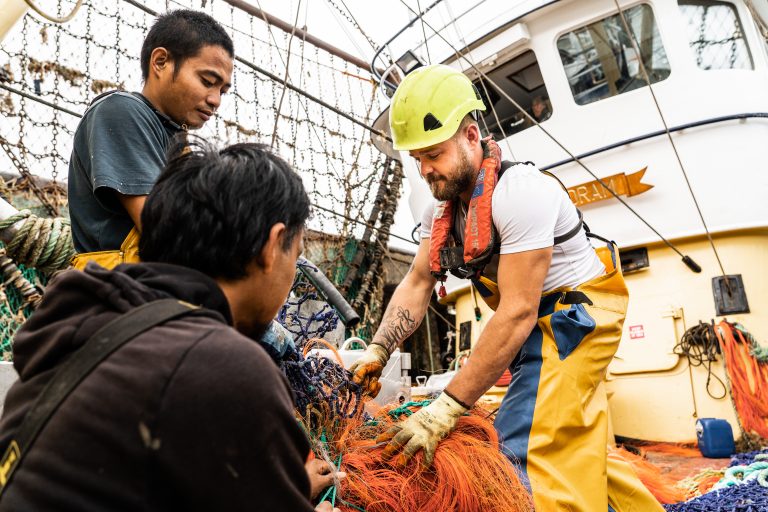Seafish Advanced Stability
This course is the follow on from the Seafish Stability Awareness for Experienced Fishermen Course. The Advanced Stability Awareness course is required for anyone working towards the Under 16.5m Skippers Certificate at both levels, restricted within 20 miles and unrestricted beyond 20 miles. The intermediate course should be completed first.
On completion of this course, you will understand:
How poor vessel stability links to deaths in the fishing industry
Risk, the ALARP principal, ‘Event and Consequence’ and the Risk Spectrum
The responsibilities of the skipper in respect to managing stability risks
Event chains using event and consequence diagrams
How weight and the shape of a vessel contributes to vessel stability
The stability of both ballast stable and form stable boats
Initial (GM) and static stability (GZ)
The methods used to monitor risks to stability
The risks posed by external forces, the transverse movement of weight, the FSE and the up-ward movement of weights and the condition of a vessel are managed
How vessel watertight and weathertight integrity is managed to minimise risk
How vessel condition and modifications are managed to maintain stability
How to monitor and maintain the stability of a vessel during fishing operations
How fishing vessel stability books manage the stability risk on fishing vessels
The role of regulation and the regulatory organisations concerned with fishing vessel stability
There will be a short test at the end of the day, comprising of 20 short answer questions worth 2 marks and 1 essay question worth 10 marks. This 1-day Seafish certified course is being held at a local venue for practical assessment, as well as our Marine Academy on Dart Marina.
If you apply for a Seafish course through the college, you will be charged the full rate. There may be funding available to you from Seafish. If you think this might be the case, please contact Seafish before making your application.

Course Details
- You should have a genuine interest in this subject
How poor vessel stability links to deaths in the fishing industry
Risk, the ALARP principal, ‘Event and Consequence’ and the Risk Spectrum
The responsibilities of the skipper in respect to managing stability risks
Event chains using event and consequence diagrams
How weight and the shape of a vessel contributes to vessel stability
The stability of both ballast stable and form stable boats
Initial (GM) and static stability (GZ)
The methods used to monitor risks to stability
The risks posed by external forces, the transverse movement of weight, the FSE and the up-ward movement of weights and the condition of a vessel are managed
How vessel watertight and weathertight integrity is managed to minimise risk
How vessel condition and modifications are managed to maintain stability
How to monitor and maintain the stability of a vessel during fishing operations
How fishing vessel stability books manage the stability risk on fishing vessels
The role of regulation and the regulatory organisations concerned with fishing vessel stability
Course Applications
Please choose your preferred study option below (subject to change).
This course costs: £120.00
If the amount shown is more than £0.00 and you are aged 19 and over at the start of the course, you may have options to help fund your studies with us. The funding you can receive depends on your personal circumstances, and could mean you are entitled to fully subsidised or reduced tuition fees.
This course is fully funded for 16-18 year olds (if applicable to the course).
You may also be entitled to support with travel, childcare and equipment.
To find out exactly what you could receive, contact our Helpzone team on 08000 380 123 for a free, impartial appointment, with no commitment necessary.
"I studied the Tourism and Tourism Certificate Level 3 and loved it. I feel like I have really learnt a lot from the course about the industry and the different jobs that are out there. Since being on the course learning about all the different jobs that there is and I am now going to be a travel agent. We have really supportive teachers. I am someone that struggles with dyslexia so there has been a lot of extra support for me from the teachers. We have a lot of our teaching resources online which is really nice because you can go after the lesson and read up on something you may not have understood properly. In class, it is a very supportive environment where you feel very welcome to ask questions which are answered really well. I feel like I have learned a lot and the lessons are always really engaging; it is never a boring time on the course and is definitely very enjoyable. We also do a lot of presentations on our course. There are lots of different types of presentations and written assignments which has helped me work on my confidence with public speaking. I now quite enjoy talking in front of people. I have learned a lot of customer service skills which I think is going to really help me in my future career as a travel agent with hopes to become a manager."Liv Legg






